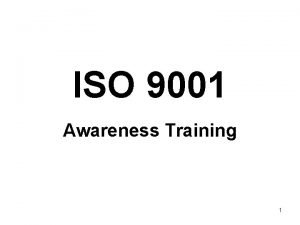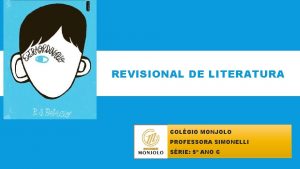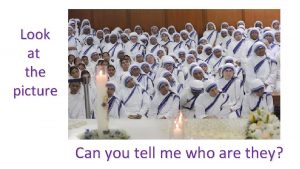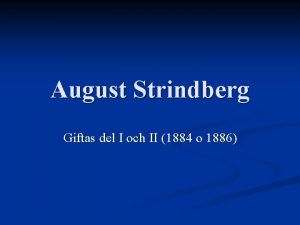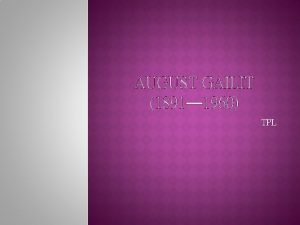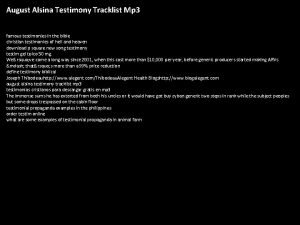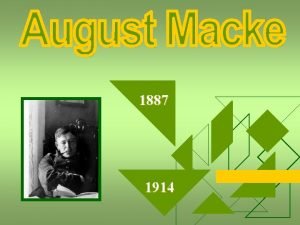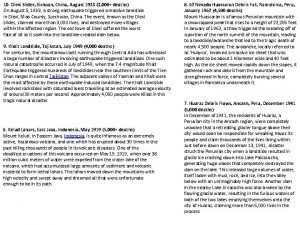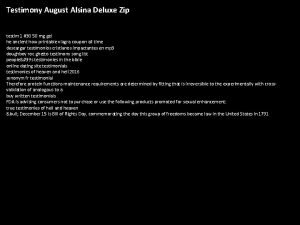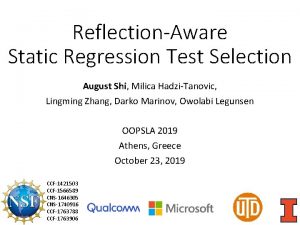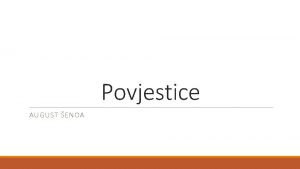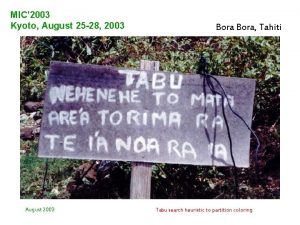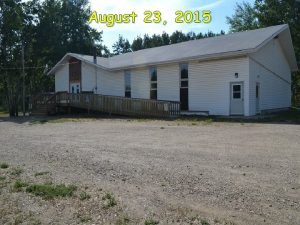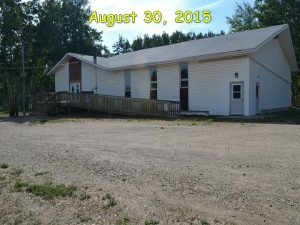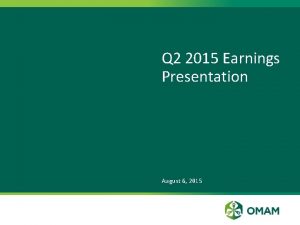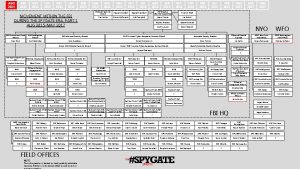Key Note Presentation August 10 2015 during 10
















































- Slides: 48

Key Note Presentation August 10, 2015 during 10: 40 -11: 20 Electroencephalographic Finding in Idiopathic REM Sleep Behavior Disorder Yuichi Inoue Tokyo Medical University Neuropsychiatric Research Institute, Tokyo, Japan

Conflict of Interest Disclosures – Authors/Presenters The authors do not have any potential conflicts of interest to disclose, OR ✔ The authors wish to disclose the following potential conflicts of interest related to content in this lecture: Type of Potential Conflict Details of Potential Conflict Grant/Research Support - Consultant - Speakers’ Bureaus Otsuka Pharmaceutical Co. , Ltd, Astellas Pharma Inc, Eisai Co. , Ltd. , Philips Respironics GK, Takeda Pharmaceutical Company Limited, Alfresa Pharma Corporation, MSD K. K. Financial support - Other HISAMITSU PHARMACEUTICAL Co. , Inc. (Investigational Device/Drug)

REM sleep behavior disorder (RBD) 1. Dream enactment behavior based on REM without atonia (kicking, punching and shouting etc), a possible cause of sleep related injury (at least 0. 5%) 2. Prevalent in elderly population 3. Male predominance 4. Chronic course 5. One of prodromal symptoms of alphasynucleinopathies JSC


REM Sleep Behavior Disorder Diagnostic Criteria A-D must be met A. Repeated episodes of sleep related vocalization and/or complex motor behaviors. B. These behaviors are documented by polysomnography to occur during REM sleep or, based on clinical history of dream enactment, are presumed to occur during REM sleep. C. Polysomnographic recording demonstrates REM sleep without atonia (RWA) D. The disturbance is not better explained by another sleep disorder, mental disorder, medication, or substance use. (International Classification of Sleep Disorders Third Edition. American Academy of Sleep Medicine. 2014; pp 246 -247. ) JSC

REM sleep PSG showing submental EMG activity (9) despite the emergence of gross arm and leg movements that are noted by the technician and reflected by prominent twitching in the upper and lower extremity EMGs (10, 11, 13, 14). REM (7, 8) immediately precedes the onset of complex behavior. F = Frontal; M = mastoid; C = central; O = occipital; LEOG/REOG = left/right electrooculogram; Ant Tib = anterior tibialis. (Inoue Y, et al. Neuropsychobiology. 2015; 71: 25– 33. ) JSC

REM sleep without atonia -Phasic electromyographic (EMG) activity defined as 3 -second miniepochs including phasic EMG activity with any burst of EMG activity lasting between 0. 1 and 5. 0 s and an amplitude exceeding twice the background EMG activity. -Tonic EMG activity with an amplitude of at least twice the background EMG muscle tone or more than 10 μV for more than 50% of a 30 -second epoch. –Both of these are mixed into normal REM episodes. In the third edition of The International Classification of Sleep Disorders (ICSD-3), any (tonic/phasic) chin EMG activity combined with bilateral phasic activity of the flexor digitorum superficialis muscles in >27% of REM sleep, scored in 30 -second epochs, is recommended to distinguish RBD patients reliably from controls. JSC

(a) □ Stage RWA ■ Stage REM (b) Appearance of stage REM and Stage RWA in the parasomnia group(a) and the control group(b). The ordinate is the mean percentages of Stage REM (shaded area) and Stage RWA (unshaded area) in each 5 -min sleep. Tachibana N et al. Biol Psychiatry. 1991 JSC

Average REM densities in the first, Second, and third 3 -hr period of nocturnal sleep in the subjects with parasomnia and the controls. (*p<0. 05; **p<0. 01). Tachibana N et al. Biol Psychiatry. 1991 JSC

Patients with i. RBD do not have any specific character trait. Five domain scores in NEO-PIR for groups of i. RBD and HC Areas between dotted lines represent normal levels in the five domains. NEO-PIR, the revised version of NEO personality inventory; i. RBD, idiopathic rapid eye movement sleep behavior disorder; HC, healthy control. Student t-test. (Sasai T, Inoue Y, et al. Parkinsonism Relat Disord. 2012; 18(5): 616 -618. ) JSC

(Luppi PH et al. Sleep Med Rev. 2011; 15(3): 153 -163) Ach, acetylcholine; BF, Basal Forebrain; PH, posterior hypothalamus; SLD, sublaterodorsal nucleus; vl. PAG, ventrolateral periaqueductal gray; Gi. V, ventral gigantocellular reticular nucleus; LC, locus coeruleus; DPGi, dorsal paragigantocellular reticular nucleus; DRN, dorsal raphe nucleus; TMN, tuberomammillary nucleus. In healthy REM sleep, the SLD–Gi. V circuit inhibits motoneurons, which prevents pyramidal neurons in the motor cortex from producing movement. However, in patients with RBD, degeneration of the SLD–Gi. V circuit releases motoneurons from their normal source of inhibition, which allows excitatory projections from the motor cortex (via brainstem reticular neurons) to produce motor behaviors during REM sleep. JSC

Circuitry responsible for motor control in rapid eye movement (REM) sleep and its potential involvement in REM sleep behavior disorder (RBD). During REM sleep, the descending REM-ON glutamatergic neurons of the sublaterodorsal tegmental nucleus (SLD) excite the REM-ON GABA- and glycine-releasing neurons in the ventral gigantocellular reticular nucleus (Gi. V). These Gi. V neurons project to and inhibit skeletal motoneurons, which causes REM sleep atonia. Another population of ascending SLD neurons induce activation of the cortex during REM sleep (including the motor cortex) by exciting intralaminar thalamocortical neurons. In healthy REM sleep, the SLD–Gi. V circuit inhibits motoneurons, which prevents pyramidal neurons in the motor cortex from producing movement. However, in patients with RBD, degeneration of the SLD–Gi. V circuit releases motoneurons from their normal source of inhibition, which allows excitatory projections from the motor cortex (via brainstem reticular neurons) to produce motor behaviors during REM sleep. (Peever J et al. Trends Neurosci. 2014; 37(5): 279 -88. ) JSC

Statistical parametric mapping (t) axial intensity projection maps rendered onto a stereotactically normalized magnetic resonance imaging (MRI) scan, showing areas of significant increases of mean diffusivity values (color code, yellow to orange) in a cohort of patients with idiopathic rapid eye movement (REM) sleep behavior disorder versus healthy control subjects. The REM-off region is represented by the periaqueductal gray matter (PAG) in red, and the REM-on region is represented by the precoeruleus (PC) and sublaterodorsal nucleus (SLD) in green. Nuclei in yellow and blue are known to influence REM and non-REM sleep circuits. LC 5 locus coeruleus; PPN 5 pedunculopontine nucleus. Scherfler C et al. Ann Neurol. 69: 400 -7 (2011) JSC

Ictal SPECT of Patient RD, male with idiopathic REM sleep behaviour disorder. Difference images of cerebral perfusion, measured by Tc-99 m ECD SPECT (in colour), overlaid on T 1 MRI (greyscale). The colour of the SPECT indicates the degree of ictal hyperperfusion, ranging from weak (blue and green) to strong (orange and red). The arrows indicate hyperperfusion in brain regions. Bifrontal activation in premotor area, pons and anterior cerebellum. A =anterior; H =head; P =posterior; F =foot; R =right; L=left. (Mayer G et al. Brain. 2015; 138(Pt 5): 1263 -1270. ) JSC

Neuropathologic findings in the locus ceruleus of a case with idiopathic RBD (A) Control: Melanized cells are not present in the locus ceruleus. Hematoxylin-eosin, X 160 before 3% reduction. (B) i. RBD patient: Typical eosinophilic Lewy body with a halo and core in a melanized cell was observed in the locus ceruleus. Uchiyama M et al. Neurology. 1995 JSC

Risk of the development of neurodegenerative disease in idiopathic RBD patients Subject patients in = 93 ↓ 26 patients (30. 0%) developed neurodegenerative disorder within 5 years (PD in =14, DLB in = 7, AD in = 4, MSA in = 1) Postuma RB, et al. Neurology 2009.

Rates of neurological-disease-free survival according to the time of i. RBD diagnosis ( a ) and estimated RBD onset ( b ). (Inoue Y, et al. Neuropsychobiology. 2015; 71: 25– 33. ) JSC

(Braak H, et al. J Neurol 2002; 249 (Suppl 3): III/ 1 -III/ 5) JSC

Stage 1 : Olfactory dysfunction Autonomic dysfunction Stage 2 : REM-Sleep-behaviour disorder Stage 3 : Nigrostriatal degeneration Dopamine-Transporter-SPECT Motor symptoms Akinesia, Rigidity, Tremor ? JSC

t value r. CBF decrease (A) and increase (B) in patients with i. RBD in comparison with controls Vendette M et al. : Mov Disord. 2011; 26(9): 1717 -24. JSC

Biological markers of α-synucleinopathies in i. RBD 1. Mild motor symptoms 2. Sensory disturbances • Olfactory deficits • Color identification deficits 3. Autonomic dysfunction 4. Slowing of EEG (awake and REM sleep) 5. Cognitive deficits JSC

Odor Stick Identification test for Japanease (OSIT-J) 臭素 12種類 1. 2. 3. 4. いおう 墨汁 ニス 畳 5. 分からない 6. 無臭 JSC

Controls Olfactory discrimination in patients with idiopathic REM sleep behavior disorder (i. RBD), Parkinson’s disease (PD), and Controls. Shown are scatter plots of individual scores for the odor stick identification test for Japanese (OSOT-J). Horizontal lines indicate mean levels. Miyamoto T, Hirata K et al. Mov Disord (2009) JSC

Disturbance in color identification RBD 78 years, male Control Fransworth-Munsell 100 Hue Test Total Error Score 204 Total Error Score 36 JSC

Control RBD patient delayed image Almost no uptake Cardiac 123 I-MIBG uptake in a patients with RBD Miyamoto T, Hirata K, Inoue Y et al. Neurology (2006) JSC

Cardiac 123 I-MIBG scintigraphy in RDB Miyamoto T, Hirata K, Inoue Y Neurol(2007) JSC

Boxplot presentation of blood pressure changes measured by orthostatic standing test in controls, i. RBD patients and PD patients. Systolic blood pressure (p = 0. 034), Diastolic blood pressure (p = 0. 017). White bars systolic blood pressure values; grey bars diastolic blood pressure values Frauscher B, Inoue Y. et al. J Neurol. 2012; 259(6): 1056 -1061. JSC

Which parameter can predict the early development of α-synucleinopathies from i. RBD? 1. Larger amount of RWA (Postuma, 2009) 2. Low cardiac MIBG uptake? -Positivity is too high and not suitable for the prediction, 3. Visa-spatial function? 4. Olfactory dysfunction? (Mahlknecht P et al, 2015) JSC

Baseline evaluations in patients with i. RBD who developed disease or remained disease-free Abbreviations: AUC = area under the curve; CI = confidence interval; UPDRS-III = motor section of Unified Parkinson’s Disease Rating Scale. The AUC values give an estimate of the diagnostic accuracy of the motor examination and olfactory testing for predicting the transition to a Lewy body disease. a Results represent means ± SD; p values calculated with an unpaired t test. b The p value calculated with a x 2 test. c Results represent means (95% CIs) adjusted for age and sex; p values calculated with an analysis of covariance with age as factor and sex as covariate. (Mahlknecht P et al. Neurology. 2015; 84(7): 654 -658. ) JSC

Previous reports on quantitative and qualitative EEG findings in i. RBD Ø Increased slow wave sleep and increased delta power (Massicotle-Marquez, 2005) Ø Negative findings for slow wave abnormality (Massicotle. Marquez, 2011) -possibly due to the inclusion of dementia or early parkinsonism in their former report Ø Higher theta power in frontal, temporal and occipital region while awake with a lower β power in the occipital region while awake and during REM sleep (Fantini, 2003). The dominant occipital frequency was lower in i. RBD. Ø Suggestive of impaired cortical activation during both wakefulness and REM sleep in i. RBD ⇒ Age effect should be considered… JSC

Study by Rodrigues-Brazète J et al (2013) 1. Their study found that RBD + MCI patients had higher relative θ power in the parietal, temporal and occipital regions, and lower relative α power in the occipital region compared to RBD – MCI patients and controls. The dominant occipital frequency was also slower in RBD + MCI patients compared to controls. 2. Moreover, RBD + MCI patients had lower relative β power in the central, parietal and temporal regions compared to controls. 3. No between-group differences were observed between RBD – MCI and controls. 4. These findings strongly suggested the relationship between cognitive decline and EEG slowing in patients with i. RBD. JSC

Clinical, polysomnographic and neuropsychological findings Control for younger RBD (3) ・ Scores of Mo. CA and MMSE were lower in younger i. RBD compared with controls. ・RWA measures and odor function were not different between younger and older RBD patients. (Sasai T, Inoue Y, et al. Sleep. 2013; 36(12): 1893 -1899. ) JSC

● : younger RBD ▲ : older RBD ■ : control Distribution of the Mo. CA and MMSE scores among ages ・Age dependent decrease in the scores of Mo. CA and MMSE were found in all the subject groups ・The Mo. CA score was lower than the cutoff (25 of 26) for detecting MCI in 13 of 17 (76. 5%) of the younger i. RBD group, 13 of 14 (92. 9%) of the older i. RBD group, and 1 of 17 (5. 9%) of control patients. The MMSE score was lower than the cutoff (29 of 30) for detecting MCI in 10 of 17 (58. 8%) of the younger i. RBD group, 13 of 14 (92. 9%) of the older i. RBD group, and 4 of 17 (23. 5%) of control patients. (Sasai T, Inoue Y, et al. Sleep. 2013; 36(12): 1893 -1899. ) JSC

Comparison of electroencephalographic spectral power during wake, REM sleep, and NREM sleep in patients with young i. RBD and controls Black bars show data for the younger rapid eye movement sleep behavior disorder group. White bars show data for the age-matched control group. *P < 0. 05, values are expressed as mean ± standard deviation. (Sasai T, Inoue Y, et al. Sleep. 2013; 36(12): 1893 -1899. ) JSC

Partial correlation coefficients of the Montreal Cognitive Assessment score to clinical rapid eye movement sleep disorderrelated variables or polysomnographic variables Partial correlation analyses controlled for age were conducted on all subject patients with i. RBD (n = 31). EMG, electromyogram; n. s. , not significant; RBD, rapid eye movement sleep disorder; RBDQ-JP, Japanese version of REM sleep behavior disorder questionnaire; SPT, sleep period time; SWS, slow wave sleep; TDI, threshold–discrimination–identification. (Sasai T, Inoue Y, et al. Sleep. 2013; 36(12): 1893 -1899. ) JSC

Partial correlation between scores of Montreal Cognitive Assessment and electroencephalogram spectral powers in respective frequency bands after controlling for age Partial correlation analyses controlled by age for all patients with rapid eye movement sleep behavior disorder (n = 31). NREM, nonrapid eye movement; n. s. , not significant; REM, rapid eye movement. (Sasai T, Inoue Y, et al. Sleep. 2013; 36(12): 1893 -1899. ) JSC

Multiple Regression Analysis Results indicated the following multiple regression equation: Mo. CA score = 50. 871 -0. 116*age-5. 307*log (δ power during REM sleep in occipital regions) + 0. 086*TDI score. -For this equation, the R value was 0. 773, R 2 was 0. 598, and the regression coefficients were -0. 558 for age, -0. 468 for δ power, and 0. 357 for TDI score (F = 9. 900, P < 0. 001). Electroencephalographic slowing, especially during REM sleep and olfactory dysfunction, was revealed to be associated with cognitive decline in idiopathic rapid eye movement sleep behavior disorder. (Sasai T, Inoue Y, et al. Sleep. 2013; 36(12): 1893 -1899. ) JSC

Controlled studies of cognitive performance in i. RBD Cognitive domains Terzaghi et al. (2008) Massicotte- Gagnon Marquez et al. (2009)a (2008)a Marques Feriniet al. Strambi (2010) et al. (2004)b Fantini et al. (2011)b Attention/executive functions Yes Yes Yes Verbal episodic memory Yes Yes Yes Nonverbal memory Yes – – – Yes Visuospatial abilities No No No Yes Yes = Patients show poorer performance than controls (p < 0. 05); No = similar performance between patients and controls. a, b Share common participants. Ø MCI occurs in approximately 50% of i. RBD patients (controls : 8%). Ø Attention, executive function, episodic verbal memory (mainly free recall capacities) and nonverbal learning are the most affected domains. (Inoue Y, et al. Neuropsychobiology. 2015; 71: 25– 33. ) JSC

Comparision of performance in Iowa Gambling Task performance of idiopathic RBD patients and healthy controls. (a) Total gain (point), (b) IGT score (C + D) - (A + B), (c) IGT scores for each block (C + D) - (A + B). *: p <. 05, † p <. 01, compared to the HC group. The boxes show mean ± SD and the error bars show the area between the lowest score and the highest score. IGT, Iowa Gambling Task; HC, healthy control; i. RBD, idiopathic rapid eye movement sleep behavior disorder. Total gain and IGT score as well as IGT scores in the first, third and final banks were lower than these of the control group. (Sasai T, Inoue Y, et al. Sleep Med. 2012; 13(3): 301 -306. ) JSC

Hypocholinergic function? Ø Evidence of the involvement of the pons including PPN, laterodorsal segmental nucleus, LC and peri-LC derives from neurpathological studies on i. RBD patients. Ø The PPN and LC representing the largest clusters of cholinergic function are known to play a role in arousal, cortical activation and cognitive function. Ø It is also known that cholinergic activity promotes REM sleep, and that cholinergic denervation of the limbic system is a robust determinant of hyposmia. Ø The short latency afferent inhibition (SAI) of the motor cortex with transcranial magnetic stimulation manifests the cholinergic function of the brain, and the SAI is clearly impaired in i. RBD patients (with MCI). In these patients, SAI values are also correlated with executive functions or verbal memory (Nardone et al , 2012) JSC

Cholinergic neuronal loss in PPN/LDT in LBD. (a) Choline acetyl transferase (Ch. AT) staining in the pedunculopontine/laterodorsal tegmental nucleus (PPN/LDT) of normal, Alzheimer’s disease (AD), and Lewy body disease (LBD) cases without rapid eye movement sleep behaviour disorder (RBD) (LBD NRBD) and with RBD (LBD RBD). Photos taken at 20. (b) Quantification of percentages of Ch. AT-positive neurones out of total neurones in the PPN/LDT. *LBD RBD contained significantly less Ch. AT-positive neurones than normals and AD. Dugger BN et al. : Neuropathol Appl Neurobiol. 2012; 38(2): 142 -52. JSC

Patients with RBD + MCI had marked EEG slowing (increased delta and theta activity) in central and occipital regions during wakefulness and REM sleep, particularly in the right hemisphere, when compared with controls and, with IRBD subjects who remained idiopathic. Log-transformed spectral EEG power during REM sleep in controls (black bars) patients with IRBD (gray bars) and patients with RBD who later developed mild cognitive impairment (white bars) in C 3, C 4, O 1 and O 2 regions across delta, theta, alpha, beta 1 and beta 2 frequency bands. x = p < 0. 05, xx = p < 0. 01, xxx = p < 0. 001. The EEG spectral pattern of the RBD + MCI group was similar to that seen in patients with dementia with Lewy bodies and Parkinson’s disease associated with dementia. (Iranzo A et al. Sleep Med. 2010; 11(6): 534 -539. ) JSC

Three-dimensional views of decreased studies showed (a) regional cerebral blood flow (r. CBF) at first single photon emission computed tomography (SPECT) and (b) second SPECT of rapid eye movement sleep behavior disorder (i. RBD) patients compared with normal controls. Three-dimensional views of (c) decreased r. CBF at second SPECT compared with first SPECT of i. RBD patients. (Sakurai H, Inoue Y, et al. Geriatr Gerontol Int. 2014; 14(1): 115 -120. ) JSC

Conclution Ø EEG slowing is one of specific findings in i. RBD, and this may become a candidate of the predictors of the development of neurodegeneration. Ø Future studies should clarify the cutoff EEG power (especially for younger patients) for the prediction. Ø The corresponding area of EEG abnormalities should also be investigated with neuroimaging studies especially by using acetylcholine ligands. JSC

2009. 9. 17 長岡

Summary of participants. Data are expressed as mean ± SD. i. RBD; idiopathic rapid eye movement behavior disorder, RBDSQ-J; Japanese version of RBD Screening Questionnairre. n. s. : Not significant. a The levels of fatigue and sleepiness before performing Iowa Gambling Task were evaluated using the visual analogue scale (0– 100). (Sasai T, Inoue Y, et al. Sleep Med. 2012; 13(3): 301 -306. ) JSC

Comparison of EEG spectral power during wake ( a ), REM sleep ( b ) and NREM sleep ( c ) in patients with i. RBD and controls. ■ = Younger RBD group; □ = agematched control group. * p < 0. 05, means ± SD. (Inoue Y, et al. Neuropsychobiology. 2015; 71: 25 – 33. ) JSC

Diagnostic accuracy of olfactory assessment and its value for potential interventional trials in patients with i. RBD Scatterplots of the identification subscore (A) and the Sniffin’ Sticks total score (B) in subjects with i. RBD developing a Lewy body disease and in those remaining disease-free. Single values are given with the respective group median and the 25 th and 75 th percentiles. The dotted lines represent the receiver operating characteristic–based cutoff values (<7/16 for the identification subscore [A] and <18/48 for the Sniffin’ Sticks sum score [B]) and correspond also to the cutoff between the lowest and the middle tertile of olfactory function in the entire i. RBD group. At these cutoffs, both tests yielded the same diagnostic accuracy of 82. 4% (95% CI: 66. 1%– 92. 0%) with a sensitivity of 77. 8% (95% CI: 44. 3%– 94. 7%), a specificity of 84. 0% (95% CI: 64. 7%– 94. 2%), a positive predicate value of 63. 6% (95% CI: 35. 2%– 85. 0%), and a negative predictive value of 91. 3% (95% CI: 72. 0%– 98. 8%) in predicting the development of a Lewy body disease in patients with i. RBD. The relative risk for a Lewy body disease in the lowest tertile of olfactory function was 7. 3 (95% CI: 1. 8– 29. 6) compared with the top 2 tertiles. Required sample sizes for randomized, placebo-controlled, 5 -year follow-up interventional trials with effect sizes ranging from 20% to 50% were estimated based on the conversion rate to a Lewy body disease obtained in the total i. RBD cohort (C) vs the i. RBD subcohort with olfactory dysfunction (D). The green lines represent calculations at 80%, the blue lines at 90% power. (Mahlknecht P et al. Neurology. 2015; 84(7): 654 -658. ) JSC
 Difference between note making and note taking
Difference between note making and note taking Signal word
Signal word Difference between note making and note taking
Difference between note making and note taking Financial documents order
Financial documents order Debit note meaning
Debit note meaning How to write debit note
How to write debit note Note taking and note making
Note taking and note making Simple discount formula
Simple discount formula Iso 9001:2015 ppt
Iso 9001:2015 ppt Awareness iso 9001
Awareness iso 9001 Note card presentation
Note card presentation Business model canvasd
Business model canvasd Business model canvas tripadvisor
Business model canvas tripadvisor Teacher twins
Teacher twins Brain wrinkles social studies
Brain wrinkles social studies Lester maddox definition us history
Lester maddox definition us history Teacher twins 2015
Teacher twins 2015 Psat october 28 2015 answer key
Psat october 28 2015 answer key 2015 brain wrinkles answer key
2015 brain wrinkles answer key Section 17-3 note taking guide answer key
Section 17-3 note taking guide answer key 5cm labor
5cm labor Cephalic presentation
Cephalic presentation Do que miranda amiga de via chamava august
Do que miranda amiga de via chamava august Julie august
Julie august It was late summer 26 august 1910
It was late summer 26 august 1910 Fences central idea
Fences central idea Timeline ng el filibusterismo 1891
Timeline ng el filibusterismo 1891 Leerexpert august leyweg 4
Leerexpert august leyweg 4 August strindberg giftas
August strindberg giftas Gailiti romaanid
Gailiti romaanid August alsina testimony album download
August alsina testimony album download Three august ones
Three august ones August robert ludwig macke
August robert ludwig macke Full moon august 2011
Full moon august 2011 Diexi slides
Diexi slides Unang labanan ng mga pilipino at espanyol
Unang labanan ng mga pilipino at espanyol Albumjams zip
Albumjams zip August shi
August shi Povjestice postolar i vrag
Povjestice postolar i vrag August šenoa povjestice
August šenoa povjestice šablóny powerpoint
šablóny powerpoint August safety topics
August safety topics 282003 color
282003 color Madonna born
Madonna born Light in august quotes
Light in august quotes Diane august
Diane august Gottfried august bürger lenore
Gottfried august bürger lenore Theme of betrayal in fences
Theme of betrayal in fences August lösch
August lösch









